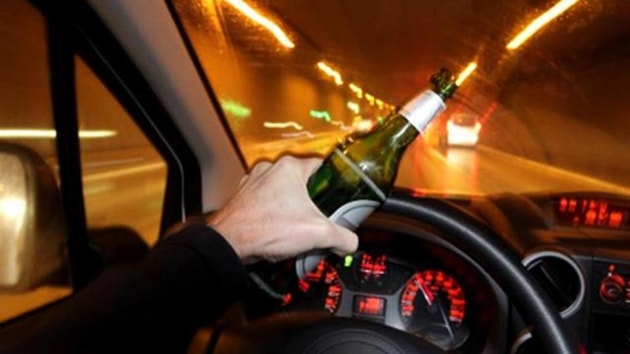Drink driving within limit? Bad idea, says IIT-B
The two-member IIT-B team conducted the study on 56 men and 19 women drivers on a fixed-base driving simulator on a 4-km stretch.
Indians who drive under the influence of permissible limits of alcohol – lower than the cap set in the United States of America (USA), United Kingdom (UK) or Australia – display significant impairment in driving performance, a first-of-its-kind study by the Indian Institute of Technology (IIT)-Bombay has revealed. The study, which comes against the backdrop of the Centre imposing stricter road norms and heavier penalties for drink driving, aims to create scientific literature to find out if India needs to re-examine existing legal limits.

The Motor Vehicles Act, 1988, allows maximum Blood Alcohol Concentration (BAC) of 0.03% or 30mg in every 100ml blood for Indians – similar to Russia, Chile and Japan. BAC is higher at 0.08% or 80mg of alcohol in 100ml of blood in the US and UK, and 0.05% or 50mg in South Africa and Australia. Studies have shown that alcohol harms a driver’s reaction time and impairs their judgment ability, increasing the chances of high-risk behavior like speeding and abrupt lane-switching.
The two-member IIT-B team conducted the study on 56 men and 19 women drivers on a fixed-base driving simulator on a 4-km stretch. They found that the average speed along the stretch, with heterogeneous traffic, consistently increased from 63.9kmph of a sober driver to 67.3kmph at 0.03% BAC, 69.4kmph at 0.05% and 72.4kmph at 0.08%. The average steering wheel angle was 4.11 degrees (sober driver), 4.48 degrees at 0.03% BAC, 4.73 degrees at 0.05% and 4.92 degrees at 0.08%.
Researchers said their findings are important as alcohol-impaired driving is a major reason behind road accidents. According to Union road and transport minister Nitin Gadkari’s reply in the Parliament, of the 54,000 road accident deaths on national highways in 2018, 5% or 2,700 were caused owing to drink driving. It also led to 14,071 road crashes in 2017, of which 4,776 were fatal.
Moreover, the consequences of intoxication on drivers in developing countries such as India remains understudied, unlike extensive research undertaken in the developed world. “During literature review, I found India had fixed 0.03% as the legal limit for alcohol in 1988, based on permissible limits set by other countries, and not scientific evidence,” said Ankit Kumar Yadav, principal investigator and research student, transportation systems engineering, department of civil engineering, IIT-B. “We want to create scientific literature specifically for India, results of which may or may not justify the existing legal limit.”
Nagendra R Velaga, co-author and associate professor, transportation systems engineering, department of civil engineering, IIT-B, said, the extent of alcohol-impairment may vary among drivers of developed and developing nations “owing to differences in their physiology, metabolism, driving conditions, drinking habits, policy enforcement and driving attitude”. For instance, studies have shown that body mass index (BMI) and secretion rates of enzymes that affect alcohol metabolism of drivers in the West vary from their Asian counterparts. “While formulating policies against drink driving, policy makers and traffic safety regulatory bodies should consider regional and cultural differences specific to drivers of a particular country. Given that mean speed was the only performance measure significantly affected at all BAC levels in our study, it can be made a suitable parameter to detect the alcohol-impaired state of drivers,” Yadav said.
Drivers in the study also had to self-analyse their performances on five parameters – mental alertness, visual ability, attention, judgment ability and sense of the surroundings – on a scale of 1 to 10. The study showed there was a significant decline in mental alertness – from 8.92 (sober drivers) to 7.75 (0.03% BAC), 7.60 (0.05%) and 7.52 (0.08). Similarly, visual ability dipped from 9.25 (no alcohol) to 8.17 (0.03%), 7.89 (0.05%) and 7.87 (0.08%). With significant impairment observed while driving across all parameters at all BAC levels, the study stated, “This shows that drivers can judge the extent of deterioration in their psychomotor control and can make a decision whether to drive or not under the influence of alcohol.”
Making road safety a priority, including stringent punishment for those driving under influence of alcohol, the government imposed a slew of revised penalties from September 1. As per the Motor Vehicles (Amendment) Bill 2019, penalty for drivers caught drunk is ₹10,000, and/or six months prison; ₹15,000 and/or two year jail for subsequent offence against the old fine of ₹2,000.
Road safety experts said 0.03% BAC limit for the country is conservative and long-term study that incorporates other variables such as BMI and alcohol metabolism of Indians will result in robust scientific evidence. “We also need more stringent deterrents for those who drive under the influence of alcohol. For instance, traffic department should record ‘drink driving’ as the reason for accident in the e-challan or insurance companies should not cover the drunk driver who has sustained injuries or damaged their vehicle,” said Ashustosh Atray, road safety consultant, Road Safe Foundation, Mumbai. “A website with a ‘hall of shame’ naming all those who have been caught drunk driving can also be maintained.”
Researchers said regulatory bodies can also use the study findings to spread awareness on the negative effects of alcohol on driver behaviour. “In India, over-speeding leads to around 70% traffic crashes (according to the Ministry of Road Transport and Highways, 2017) and since alcohol-impaired drivers tend to drive faster than their usual speed, they are at a higher crash risk,” the study read.

Stay updated with all the Breaking News and Latest News from Mumbai. Click here for comprehensive coverage of top Cities including Bengaluru, Delhi, Hyderabad, and more across India along with Stay informed on the latest happenings in World News.
Stay updated with all the Breaking News and Latest News from Mumbai. Click here for comprehensive coverage of top Cities including Bengaluru, Delhi, Hyderabad, and more across India along with Stay informed on the latest happenings in World News.





